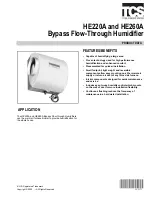
5
EGW06-PCPEG-20140813
TM
TM
Figure 1-1. Perimeter Air Distribution
ALL_AirDistributionPerimeter_20131220.eps
The warm, dry air should be directed over outside walls, windows and other surfaces susceptible to condensation, or it
can be directed down the center of the room blowing air toward the surfaces prone to have condensation. Supply ducts
should be as short and with as few turns as possible. Use turning vanes to minimize air noise and static pressure drop.
Recommended maximum supply duct air velocity is 1000 FPM. The recommended velocity from diffusers is 300 to
500 FPM. Air velocities in ducts should be kept as low as is reasonable to avoid excessive noise in the ducts. In multiple
unit installations, supply air from each unit may go into a common supply duct or into a plenum. A supply air duct
collar is provided at the fan outlet. The duct should be attached to this with a flexible connection to minimize vibration
transmission.
Sky Light
ALL_AirDistributionDown_20131220.eps
ALL_AirDistributionUp_20131220.eps
Figure 1-2. Overhead Air Distribution
SUPPLY AIR BLOWING
DOWN FROM SOFFIT DUCTS
COVERING WINDOWS AND
MOISTURE-EXPOSED AREAS
SUPPLY AIR
TO SKYLIGHTS
POOLPAK
DEHUMIDIFICATION
SYSTEM
RETURN AIR
Figure 1-3. Below Grade Air Distribution
Section I: Indoor Pool Design
BELOW GRADE DUCTING
CEILING DUCTING
RETURN AIR
SUPPLY AIR
TO SKYLIGHTS
POOLPAK
DEHUMIDIFICATION
SYSTEM
SUPPLY AIR BLOWING UP
FROM BELOW-GRADE
DUCTS COVERING WINDOWS
AND MOISTURE-EXPOSED
AREAS
SUPPLY AIR BLOWING
DOWN FROM SOFFIT DUCTS
COVERING WINDOWS AND
MOISTURE-EXPOSED AREAS
SUPPLY AIR
TO SKYLIGHTS
POOLPAK
DEHUMIDIFICATION
SYSTEM
RETURN AIR












































